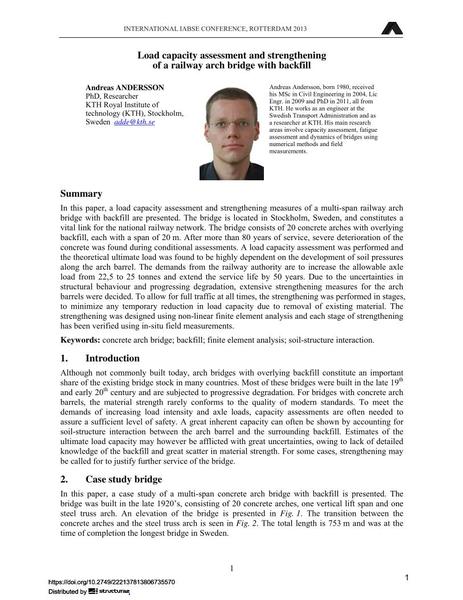Load capacity assessment and strengthening of a railway arch bridge with backfill

|
|
|||||||||||
Bibliografische Angaben
| Autor(en): |
Andreas Andersson
|
||||
|---|---|---|---|---|---|
| Medium: | Tagungsbeitrag | ||||
| Sprache(n): | Englisch | ||||
| Tagung: | IABSE Conference: Assessment, Upgrading and Refurbishment of Infrastructures, Rotterdam, The Netherlands, 6-8 May 2013 | ||||
| Veröffentlicht in: | IABSE Conference, Rotterdam, May 2013 | ||||
|
|||||
| Seite(n): | 248-249 | ||||
| Anzahl der Seiten (im PDF): | 8 | ||||
| Jahr: | 2013 | ||||
| DOI: | 10.2749/222137813806735570 | ||||
| Abstrakt: |
In this paper, a load capacity assessment and strengthening measures of a multi-span railway arch bridge with backfill are presented. The bridge is located in Stockholm, Sweden, and constitutes a vital link for the national railway network. The bridge consists of 20 concrete arches with overlying backfill, each with a span of 20 m. After more than 80 years of service, severe deterioration of the concrete was found during conditional assessments. A load capacity assessment was performed and the theoretical ultimate load was found to be highly dependent on the development of soil pressures along the arch barrel. The demands from the railway authority are to increase the allowable axle load from 22,5 to 25 tonnes and extend the service life by 50 years. Due to the uncertainties in structural behaviour and progressing degradation, extensive strengthening measures for the arch barrels were decided. To allow for full traffic at all times, the strengthening was performed in stages, to minimize any temporary reduction in load capacity due to removal of existing material. The strengthening was designed using non-linear finite element analysis and each stage of strengthening has been verified using in-situ field measurements. |
||||
| Stichwörter: |
Finite-Elemente-Analyse Boden-Bauwerk-Interaktion Beton-Bogenbrücke Betonbogenbrücke
|
||||
